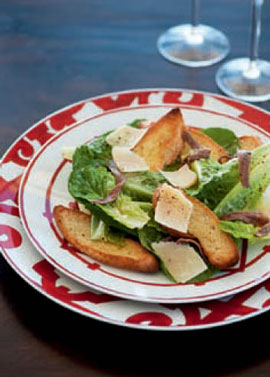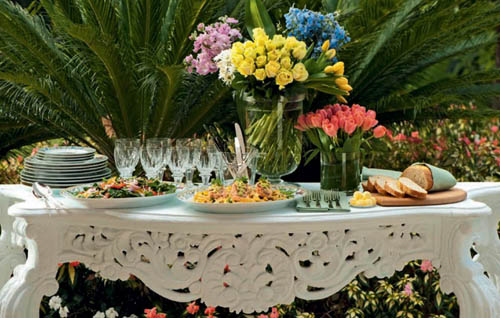Introduction

My love of entertaining started in my teens when my family or friends gathered to enjoy good food, as well as one another’s company. I am delighted that trends are swinging back to those days, and that there is a return to home entertaining. The word ‘entertaining’ is often associated with hard work and stress, but the table settings and recipes in this book will fill you with so much creativity, reflecting who you are and making every occasion a memorable one!
I have grouped the ideas and recipes into themes, but these are by no means prescriptive – shuffle them as you like to suit your personal style. I hope you will be inspired to have people over more often.
A guide to entertaining
- Set a date for the party – including the day of the week and the time of day.
- Decide on the style of the party – formal vs. informal.
- The secret to successful entertaining is in the planning – start at least a week in advance and compile the menu and shopping lists.
- Plan the main course first. If you start off light, with a salad or a soup, build up to a crescendo with an indulgent, rich dessert!
- Compile the task list in chronological order and divide the shopping list into categories, i.e. butcher, grocer and fruiterer.
- Entertaining is about what you feel like cooking and not about what tradition dictates.
- Keep things simple so that ingredients taste of what they are.
- When planning the menu, consider the age and gender of the guests. Most children, the elderly and women tend to have smaller appetites than teenagers and men.
- Use seasonal ingredients and link the food to the climatic conditions.
- Take textures and colours into account; make sure the flavours are complementary.
- Dietary requirements, food allergies and particular dislikes of guests should be taken into account.
- Combine a variety of cooking methods and avoid too many fried foods.
- Ensure the number of guests suit the location and climatic conditions.
- Group guests with compatible, as well as conflicting interests, or whatever you think will work best to stimulate conversation.
- Ensure that the food and ambience suit the guests – formal vs. informal.
- The first 15 minutes of the party are the most important – offer drinks immediately.
- Make the guests feel at home and allow your own imperfections to show!
- Don’t disappear for long periods of time – a well-planned menu demands no more than 15 minutes of last-minute preparation.
- Music establishes and sustains an easy mood – keep the volume low at the start and adjust according to the tone of the party.
- For evening parties, use a combination of lighting and candlelight. Use unscented candles as part of the table setting and scented candles elsewhere.
- For more formal events use name cards at each place setting. Create something eye-catching and unusual.
- Store the prepared food in the fridge in the order of serving – this saves time when serving, and ensures that nothing is left behind.
- Check the menu so that everything is ready for serving with all the utensils at hand.
- The seating arrangements should suit the style of the party. At a formal party, place the host at the top of the table and the female guest of honour to the right of the male host. The male guest of honour should be seated to the right of the hostess. Avoid seating couples together; alternate men and women.
- Pace the meal and don’t clear the table until everyone has finished eating.
- Serve coffee in the living room to create a different ambience and allow the guests to relax away from the dining table.
- Assess the event afterwards and be honest with yourself about where you went wrong.
- Keep a guest book and a record of what you served to whom so as to avoid giving the same guests the same menu when next you entertain.
- REMEMBER: GOOD COMPANY + GOOD FOOD + A GOOD SETTING + GOOD PLANNING = A GREAT TIME!
Serving styles
There are many different ways to serve a meal – those most commonly used entertaining are:
PLATE OR RESTAURANT STYLE : The food is plated individually in kitchen and works best for a small party and where the kitchen is positioned to the dining table.

BUFFET STYLE : Guests serve themselves from one or more food with easy access on all sides.

FAMILY STYLE : Platters and bowls of food are passed at the table. If the table is too small, a side table or ledge can be used a sideboard.

Consider combining different serving styles – plating the starter and dessert, serving the main course buffet style.




Table settings and decorative elements
- Select and iron the linens you plan to use, a day in advance.
- A table is an empty space, therefore it is important to have a focal point such as a candelabra or a flower arrangement as a centrepiece.
- Set the table at least six hours before the guests arrive. It is the crockery, glassware, flowers, candles and linen with which you dress the table that makes the occasion special.
- One of the easiest ways to change the appearance of a table is to combine linens with different textures. For formal meals, use a matching cloth and napkins, and for a more casual look, combine different colours.
- Buying one new piece of crockery can completely transform the table. Be creative with your choice of colours, textures and shapes.
- Clear glasses go well with any setting, but it is also fun to introduce some coloured glasses. And of course there is nothing quite like crystal to add that extra sparkle!

Glassware
Selecting glassware is a matter of personal taste and the the thinner glass, the better the quality. Ensure that all has a cut and polished lip.
WHITE WINE: A stemmed, tulip-shaped glass with a top.
TUMBlER: A short glass with no stem.
PORT OR DESSERT WINE: A short-stemmed, tulip-shaped glass.
CHAMPAGNE FLUTE: A tall, tapered glass that traps the bubbles in the champagne or sparkling wine.
ALL-PURPOSE WINE: A short-stemmed, longish tulip-shaped glass.
BRANDY OR COGNAC: A short-stemmed, tulip-shaped glass with a deep, round bowl.
HIGHBALL: A tall glass with straight sides.
RED WINE: A stemmed, tulip-shaped glass with a tapered top and a larger bowl than a white wine glass.
LIQUEUR: A small, short-stemmed, tulip-shaped glass smaller than a port glass.
MARTINI: A shorter-stemmed glass with a larger V-shaped bowl than a cocktail glass.
Dinnerware
Good quality dinnerware with a simple design can work for any occasion. You can also mix in an antique or colourful piece to suit individual styles. White china is always a safe bet and won’t upstage the food being served. Chargers or underplates are also popular and serve as a base under the first course plate; these should be removed when the main course is served.
Cutlery
Good quality cutlery with a simple, timeless design works best for any occasion. Stainless-steel cutlery is a good choice for most meals, while sterling silver or silver-plated (e.g. EPNS) cutlery may be reserved for special occasions.
Servingware and utensils
White platters and bowls, and silver or stainless-steel utensils will match any dinnerware. It is a good idea to add some coloured and patterned pieces to create interest. You can never have sufficient large spoons, serving forks, spatulas, and lifters at hand for serving.

Pairing wine with food
Selecting wines that will work best with food is a matter of personal taste and there is only one rule when it comes to food and wine pairing: pair those you like the most! Wine and food complement each other best when their qualities are the same or in contrast. In the same way that fresh lemon is squeezed onto oysters or Parmesan is grated over pasta to combine flavours, so too pairing the of the food and wine creates different flavours, textures and aromas. Always serve wines from light to heavy as the meal progresses; serve whites before reds, and dry wines before sweet wines. Sauces on food also affect the wines: a grilled breast of chicken will match well with a light-bodied white wine such as a Chenin Blanc, but if you add a rich sauce, serve a medium- to full-bodied white wine such as a Chardonnay.
When selecting the wine (or wines) to complement a meal, take the following into account:
The body – is it light or heavy?
The flavour – what does it taste of, citrus, berry or apple?
The character – is it dry or fruity, what is the level of acidity?
The intensity – is it bold or delicate?
| TYPE OF FOOD |
WINE MATCH |
| Appetizers and salty snack foods |
Sparkling wines and Champagne |
| Spicy or smoked foods |
Fruity wines – Riesling, Gewürztraminer, Chenin Blanc |
| Rich or fatty foods |
Full-bodied wines – Chardonnay, Merlot, Cabernet Sauvignon |
| Acidic foods |
High-acid white wines – Sauvignon Blanc |
| Fish and shellfish |
Dry to off-dry whites – Chardonnay, Sauvignon Blanc, Chenin Blanc, Rosé |
| Lamb |
Medium-bodied reds – Merlot, Pinot Noir, Pinotage |
| Beef |
Full-bodied reds – Cabernet Sauvignon, Bordeaux Blends, Shiraz |
| Desserts |
Sweet wines – Noble Late Harvest, Muscat, Port |
| Goat’s-milk cheeses |
High-acid white wines – Sauvignon Blanc |
| Cream cheeses |
Fruity or sweet red wines – Noble Late Harvest, Young Pinot Noir, Tawny Port |
| Soft-ripened cheeses such as Brie or Camembert |
Full-bodied wines – Cabernet Sauvignon, Bordeaux Blends |
| Blue cheeses |
Sweet wines – Noble Late Harvest, Port, Sherry |
| Sharp, salty cheeses such as Cheddar or Parmesan |
Spicy, full-bodied wines – Cabernet Sauvignon, Shiraz |
Serving wine
- When serving a different wine with each course, allow one glass of wine per person. A 750-ml bottle of wine contains approximately five glasses. If one type of wine is served throughout, allow half a bottle per person, but keep a few bottles on hand!
- Serve sparkling wines well chilled at 6–7 °C and white wines at 7–10 °C. Reds and dessert wines should be served at a cool room temperature.
- Table settings should include a glass for each wine you are serving.
- Ensure the glasses are washed and dried with a CLEAN, lint-free cloth; often a glass will develop a bad odour from the detergent or drying cloth, or have bits of fluff on its surface.
- Open red wines an hour before serving and decant into a carafe or decanter. This will mellow a young wine and also add a decorative element to the table setting.
- Pour the wine once the guests are seated, and fill glasses between one-third and one-half full. This makes provision for swirling and allows the wine to breathe.
- When serving sparkling wine, first pour a small amount down the side of the glass, allowing the bubbles to settle before filling the glass three-quarters full.
- Pour white or red wine into the centre of the glass and lightly twist the bottle so that the last drop falls into the glass.
